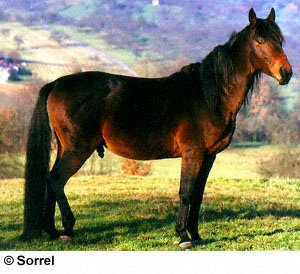Albanian
The Albanian is a small horse belonging to the Balkan group. There are two types of native Albanian horse, which are referred to as Mountain and Myzeqea (plains). In recent years interbreeding between the two types has made the distinction less clear. Traditionally the Myzeqea is larger standing at 13.2 hands and the Mountain type on average about 12.2 to 12.3 hands.
The ancient inhabitants of this area were Illyrians, Indo-Europeans who overran the northwest part of the Balkan peninsula around the fifth century B.C. The Serbians settled here during the seventh century A.D. and were overpowered by the Turks in 1386. During the Ottoman Empire, a great deal of Arab blood was infused into the local horses, which were likely various combinations of Tarpan, Turkmenian, and Mongolian stock. The Albanian knighthood of Skanderbeg was a rear force for this national hero, terrifying the Osman invaders (Ottoman Empire) and bringing honor and glory to the country.
The Albanian is known for its freedom of movement, agility in difficult terrain, disease resistance, and endurance. In the past these horses were used more for transport and riding than for agricultural purposes. In the early 1990's, measures were taken to promote and increase the number of Albanian horses and to improve them for agricultural work. The improved breeds are concentrated in large breeding centers such as the Zootechnic Station at Shkodra and at specialized farms where stallions are produced for improving local horses. Since 1980 there has been a great increase in the number of horses in Albania.
The Myzeqea is very good for long distance use and is exceptionally strong for its size and many have an easily ridden ambling gait. The Albanian are hardy efficient horses. They are often used as carriage horses as well as for riding and light draft.
The goals of Albanian breeders today are concentrated increase in number and improvement. Purebred Arab, Nonius, and Haflinger horses are crossed with the native Albanian and several improved types are emerging. The native horse of Albania has few disadvantages of quality, the main need being increased size for better agricultural work. The Haflinger breed was imported from Austria to help improve the working abilities of horses in the hilly regions of the country.
Reference:
Hendricks, Bonnie L., International Encyclopedia of Horse Breeds, Univ of Oklahoma Press, 1995.
Reference:
Hendricks, Bonnie L., International Encyclopedia of Horse Breeds, Univ of Oklahoma Press, 1995.
International Encyclopedia of Horse Breeds




No comments:
Post a Comment